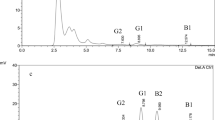Summary
A conventional TLC tank was compared with a specially designed continuous linear development chamber for the ether development phase of the quantitation of aflatoxins by bi-directional High Performance Thin Layer Chromatography (HPTLC). No significant difference was detected in the precision of the method. However, the continuous linear development chamber afforded greater accuracy in aflatoxin determination and required only half the development time and a small fraction of the solvent used in the conventional TLC tank. The ability of different concentrations of aqueous acetone, aqueous methanol and aqueous acetone: methanol (1∶1) to extract aflatoxin from naturally contaminated maize was assessed. With each system, the amount of aflatoxin extracted increased as the ratio of organic solvent: water progressed from 50∶50 to 80∶20 and then decreased or remained constant when the composition of the extraction solvent was altered to 90∶10. 80% aqueous acetone was found to extract 27% more aflatoxin than the corresponding aqueous methanol with the mixed solvent system extracting an intermediate amount of toxin. Clean-up of 80% aqueous acetone extracts of maize by elution through phenol (PH) bonded-phase cartridges resulted in poor aflatoxin retention when the proportion of acetone in 5 ml aliquots of extract was greater than 70%. This could be increased to 100% retention by the addition of an equal quantity of methanol prior to dilution with 1% aqueous acetic acid and elution through the cartridge.
Similar content being viewed by others
References
H. P. Van Egmond, Food Additives and Contaminants,6 139 (1989).
R. D. Coker, K. Jewers, K. I. Tomlins, G. Blunden, Chromatographia,25, 875 (1988).
K. I. Tomlins, K. Jewers, R. D. Coker, M. J. Nagler, Chromatographia,27, 49 (1989).
K. I. Tomlins, K. Jewers, R. D. Coker, Chromatographia,27, 67 (1989).
L. Stoloff, in “Off. Meth. of Anal. of the Assoc. of Off. Anal. Chem., 14th Ed.”S. Williams ed., Assoc. Off. Anal. Chem. Inc., Arlington, Virginia, USA, 1984, p. 477.
G. T. Wernimont, in: “Use of Statistics of Develop and Evaluate Analytical Methods”,W. Spendley, ed., Assoc. Off. Anal. Chem., Arlington, Virginia, USA (1985).
J. C. Miller, J. N. Miller, in “Statistics for Analytical Chemistry”, Ellis Horwood Ltd., Chichester (1984).
Author information
Authors and Affiliations
Rights and permissions
About this article
Cite this article
Bradburn, N., Coker, R.D., Jewers, K. et al. Evaluation of the ability of different concentrations of aqueous acetone, aqueous methanol and aqueous acetone: Methanol (1∶1) to extract aflatoxin from naturally contaminated maize. Chromatographia 29, 435–440 (1990). https://doi.org/10.1007/BF02261390
Received:
Accepted:
Issue Date:
DOI: https://doi.org/10.1007/BF02261390




